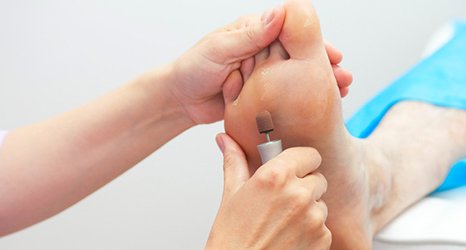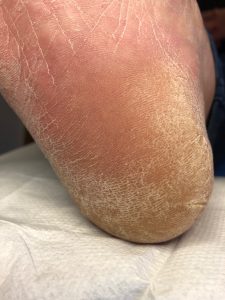
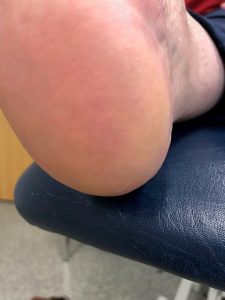
Corns and callus
The main reason that people seek treatment is for the removal of corns and calluses as they can be quite painful when walking and look unsightly. Callus is an area of thickened hard skin often found on the soles of the feet and occurs on areas of excessive pressure. Some people have a natural tendency to form calluses because of their skin type Corns appear as small concentrated areas of hard skin. Their conical shape intensifies the pressure at the tip and they can be quite painful. Corns are usually found over a bony prominence such as a joint, but can also develop on the base of the foot, on or in between the toes and even beneath the toe nails.
It is not recommended to cut corns or callus yourself especially if you are diabetic or elderly.
Corns and callus plasters contain acids that burn the healthy skin around the corn and can lead to serious problems such as infection. A podiatrist is able to remove the corns and callus and relieve any pain and redistribute pressure with soft padding. This helps the skin to return to normal.
They will also advise as to why this has occurred and if possible how to prevent it from happening again.
Thickened toe nails
Toe nails that have become thicker over time can become painful to pressure, unsightly and difficult to cut.
Thickened nails can occur as a result of major trauma such as dropping something onto the nail or multiple minor traumas as seen in hill walkers and runners.
These nails can be easily and painlessly treated by reducing the thickness of the nail with a podiatry drill.
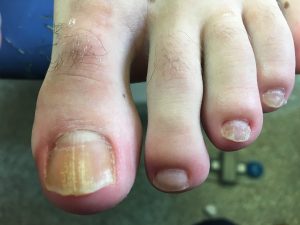 Fungal nails
Fungal nails
Fungal nails will be discoloured ranging from white, yellow to brown, they can be thickened and changed in texture. The nails may become uncomfortable due to their thickness but more of a problem is being unsightly.
If left untreated the infection can spread to the other toe nails and skin of the foot.
Treatment
To be certain that the nail does have a fungal infection enabling us to recommend the appropriate treatment we recommend a simple test. During your treatment a sample of nail is taken and tested to correctly diagnose the presence of fungal spores.
We have a range of treatments available that are more easily treated in the early stages of infection. More advanced stages can be treated using the Lacuna & ClearaNail methods. Tiny holes are drilled relatively painlessly through the nail to allow topical medication to attack the fungus. Click here for the ClearaNail page
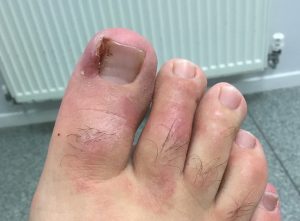 Ingrowing Toe nails
Ingrowing Toe nails
Ingrowing toe nails occur when the edge of the toe nail grows into the fleshy tissue surrounding the nail. Pain is felt if pressure is placed on the toe, and the skin appears red and swollen.
If left untreated if can become infected with the area bleeding also with the chance of developing an overgrowth of skin covering the nail. Causes of ingrowing toe nails include poor nail cutting / nail picking, wearing tightly fitting shoes, injury or just through the natural shape of the toe nail.
Treatment
This depends on the severity, if the ingrowing nail isn’t too severe it can be treated by the podiatrist who will be able to remove the ingrowing spike of nail fairly pain free. In more severe cases a local anaesthetic can be used.
The sooner an ingrowing toenail is treated the more quickly the toe will return to normal.
If the ingrowing nail doesn’t heal and is prone to reoccurring a more permanent solution can be recommended which is a partial nail avulsion. This is a procedure performed under a local anaesthetic to remove the ingrowing section of the nail. The nail bed is then cauterised by liquid phenol to prevent that part of the nail re-growing. A number of dressing appointments are required and in 4-6 weeks the toe is healed and the appearance of the nail looks normal.
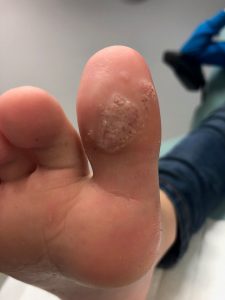 Verrucae
Verrucae
Verrucae are warts found on the foot. They are caused by a virus and are easily picked up in communal areas. They are harmless but can become painful and unsightly
Verrucae may also resolve naturally particularly with children, and can sometimes be easily treated at home with over the counter applications.
Treatment
If your self treatment is not working, the verrucae appear to be getting large and painful, or if you would prefer professional treatment then please contact one of our practices.
The podiatrist will be able to assess the verrucae and recommend a suitable treatment plan dependant on you health, activities and well being. We can offer a range of treatments to suit including acids and cryo therapy & needling.
Also available at Plant Podiatry is Swift Microwave Treatment
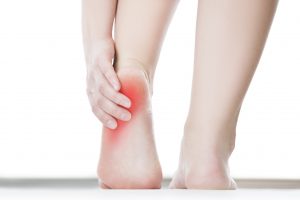
Heel pain / plantar fasciitis
The most common type of heel pain is plantar fasciitis. One of its typical symptoms is rest to rise pain, eg. pain felt in the heel when first getting up and easing after a short while.
It is usually caused by over exertion perhaps by increased activity, increase in body weight, pronating foot, and unsupportive footwear.
Treatment for plantar fasciitis is very effective, a variety of methods are available depending on individual needs. Please contact one of our practices for advice.
Other types of heel pain can be diagnosed and treated as required.
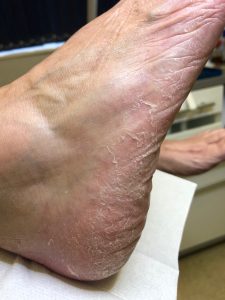 Athletes foot
Athletes foot
Athletes foot is a fungal infection of the skin which presents as a rash of small spot like blisters usually browny yellow in appearance. They quite often itch and subsequently dry up and peel leaving the skin looking dry and flaky.
Treatment is advised to prevent it spreading to the toe nails.
Prevention of reoccurrence is also important to stop re infection eg change shoes regularly to allow them to dry and breath and washing hosiery at 60 degrees
Footwear can create the necessary conditions of moisture and warmth for the fungus to develop.
Communal activity permits the spread of infection.
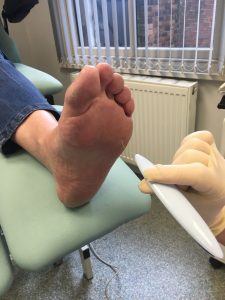 Diabetic Foot
Diabetic Foot
People with diabetes are of a high risk. The increased blood sugar levels can lead to nerve damage in the feet resulting in the loss of sensation. Therefore, any trauma or injury to the foot may not be felt leading to more serious problems such as ulceration. Blood vessels are also affected and restricted blood supply to the foot can result in cold, painful feet and delay healing, therefore increasing the risk of infection. A regular diabetic foot check will highlight an impaired circulation and nerve supply.



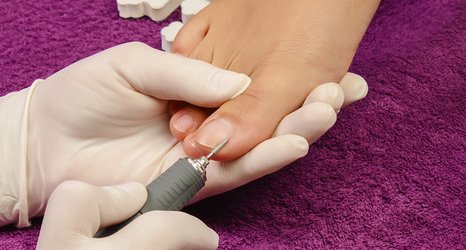
 Fungal nails
Fungal nails Ingrowing Toe nails
Ingrowing Toe nails Verrucae
Verrucae
 Athletes foot
Athletes foot Diabetic Foot
Diabetic Foot